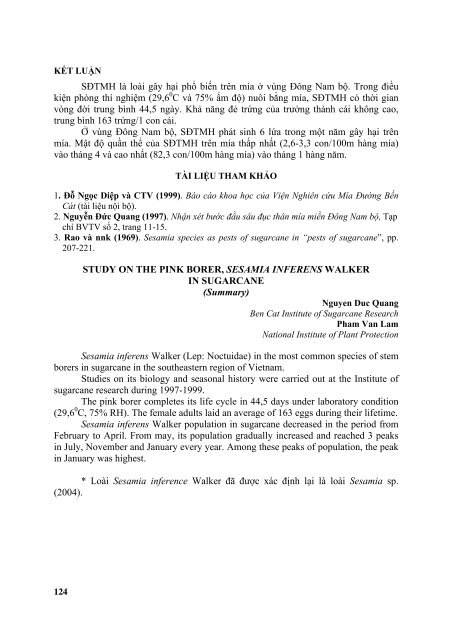TUYEÅN TAÄP
tuyeÃ¥n taäp - CHUYÃN TRANG GIá»I THIá»U CÃC GIá»NG MÃA Tá»T ...
tuyeÃ¥n taäp - CHUYÃN TRANG GIá»I THIá»U CÃC GIá»NG MÃA Tá»T ...
- No tags were found...
You also want an ePaper? Increase the reach of your titles
YUMPU automatically turns print PDFs into web optimized ePapers that Google loves.
KẾT LUẬN<br />
SĐTMH là loài gây hại phổ biến trên mía ở vùng Đông Nam bộ. Trong điều<br />
kiện phòng thí nghiệm (29,6 0 C và 75% ẩm độ) nuôi bằng mía, SĐTMH có thời gian<br />
vòng đời trung bình 44,5 ngày. Khả năng đẻ trứng của trưởng thành cái không cao,<br />
trung bình 163 trứng/1 con cái.<br />
Ở vùng Đông Nam bộ, SĐTMH phát sinh 6 lứa trong một năm gây hại trên<br />
mía. Mật độ quần thể của SĐTMH trên mía thấp nhất (2,6-3,3 con/100m hàng mía)<br />
vào tháng 4 và cao nhất (82,3 con/100m hàng mía) vào tháng 1 hàng năm.<br />
TÀI LIỆU THAM KHẢO<br />
1. Đỗ Ngọc Diệp và CTV (1999). Báo cáo khoa học của Viện Nghiên cứu Mía Đường Bến<br />
Cát (tài liệu nội bộ).<br />
2. Nguyễn Đức Quang (1997). Nhận xét bước đầu sâu đục thân mía miền Đông Nam bộ, Tạp<br />
chí BVTV số 2, trang 11-15.<br />
3. Rao và nnk (1969). Sesamia species as pests of sugarcane in “pests of sugarcane”, pp.<br />
207-221.<br />
STUDY ON THE PINK BORER, SESAMIA INFERENS WALKER<br />
IN SUGARCANE<br />
(Summary)<br />
Nguyen Duc Quang<br />
Ben Cat Institute of Sugarcane Research<br />
Pham Van Lam<br />
National Institute of Plant Protection<br />
Sesamia inferens Walker (Lep: Noctuidae) in the most common species of stem<br />
borers in sugarcane in the southeastern region of Vietnam.<br />
Studies on its biology and seasonal history were carried out at the Institute of<br />
sugarcane research during 1997-1999.<br />
The pink borer completes its life cycle in 44,5 days under laboratory condition<br />
(29,6 0 C, 75% RH). The female adults laid an average of 163 eggs during their lifetime.<br />
Sesamia inferens Walker population in sugarcane decreased in the period from<br />
February to April. From may, its population gradually increased and reached 3 peaks<br />
in July, November and January every year. Among these peaks of population, the peak<br />
in January was highest.<br />
* Loài Sesamia inference Walker đã được xác định lại là loài Sesamia sp.<br />
(2004).<br />
124






